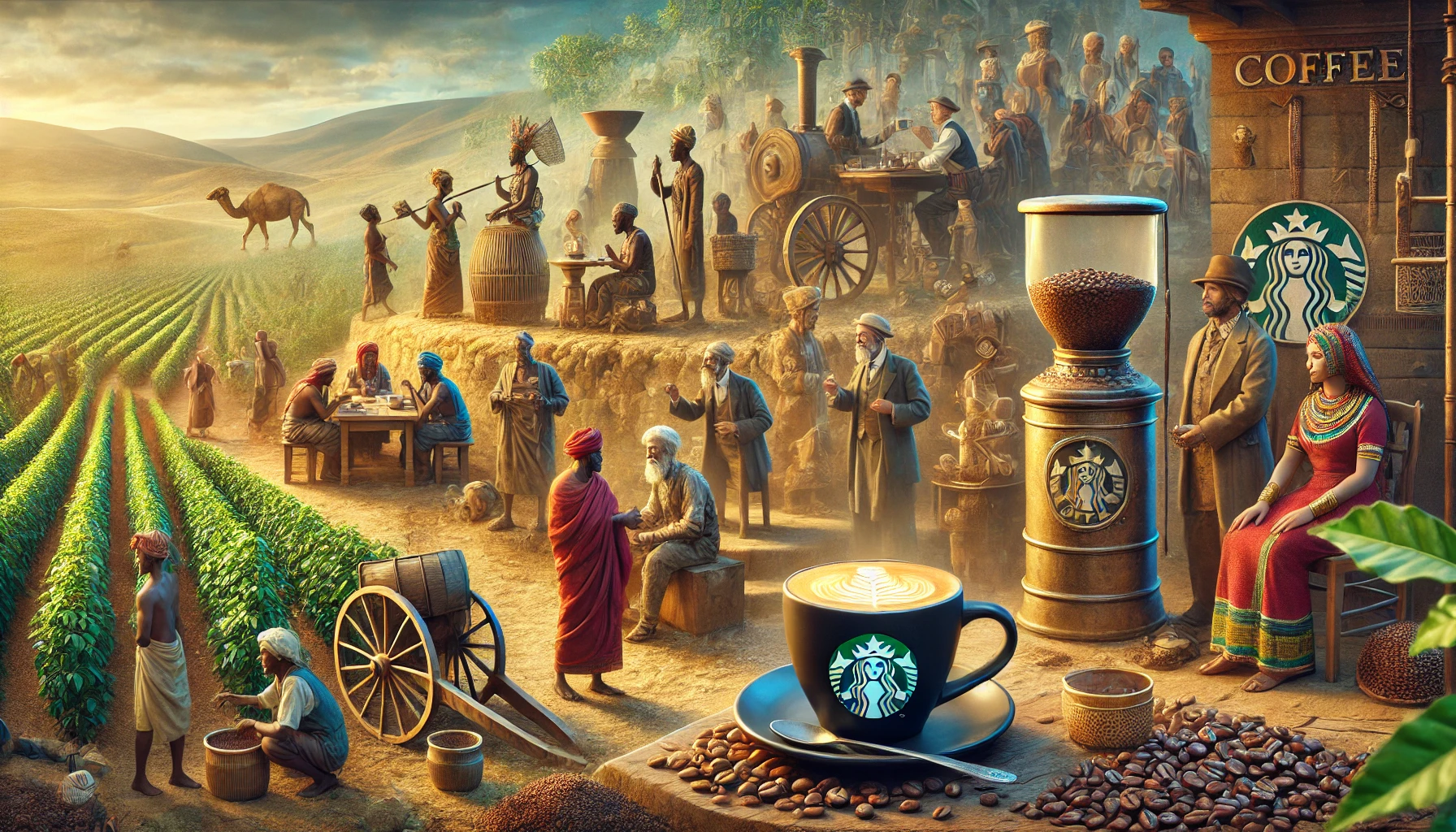Coffee has come a long way from its ancient origins in Ethiopia to become one of the most consumed beverages in the world. Over the centuries, coffee has influenced cultures, economies, and even the way we socialize. In this article, we will explore the fascinating evolution of coffee, from its discovery to its rise as a global commodity.
1. The Discovery of Coffee: A Legend from Ethiopia
The origins of coffee are shrouded in myth, with the most famous story coming from Ethiopia. According to legend, a goat herder named Kaldi noticed that his goats became unusually energetic after eating the red berries from a particular tree. Intrigued, Kaldi tried the berries himself and experienced a burst of energy. He shared his discovery with a local monk, who then brewed the berries into a drink. The monk found that the drink helped him stay awake during long prayers.
The Spread of Coffee in Ethiopia:
This is believed to be the beginning of coffee’s journey. Coffee trees grew wild in Ethiopia, and the beverage began to spread in the region, eventually becoming part of religious ceremonies and daily life.
2. Coffee’s Journey to the Arab World
By the 15th century, coffee had made its way into the Arab world, particularly Yemen, where it began to be cultivated and traded. Coffeehouses, known as qahveh khaneh, became popular in the Middle East. These establishments were centers for intellectual discussions, social gatherings, and artistic performances, and they helped spread coffee’s popularity across the region.
The Role of Coffee in the Islamic World:
In the Islamic world, coffee was initially embraced because it was a non-alcoholic beverage that helped people stay awake during long prayer sessions. It quickly became an integral part of social life in cities like Mecca, Cairo, and Istanbul.
3. The Arrival of Coffee in Europe
Coffee made its way to Europe in the 16th century, where it was met with both curiosity and skepticism. Initially, it was considered a strange and exotic drink, but by the 17th century, it gained popularity among the elite. The first coffeehouse in Europe opened in Venice in 1615, and coffeehouses quickly spread to other major cities like London and Paris.
Coffeehouses and the Age of Enlightenment:
In Europe, coffeehouses became hubs for intellectual and political debates. In England, they were known as “penny universities,” where people could discuss ideas and exchange information for the price of a cup of coffee. Figures like Samuel Pepys and John Locke were regulars at these coffeehouses.
4. Coffee Becomes a Global Commodity
As coffee’s popularity grew in Europe, the demand for coffee beans also increased. European colonial powers began to establish coffee plantations in tropical regions, including the Caribbean, Central America, and Southeast Asia. Coffee became an important export crop, and the trade in coffee beans flourished.
The Role of Coffee in the Global Economy:
By the 18th century, coffee was firmly established as a global commodity. The Dutch, French, Portuguese, and Spanish all played key roles in the spread of coffee cultivation to the New World. Brazil, in particular, became one of the largest coffee producers, and it continues to be a major player in the coffee industry today.
5. The Rise of the Coffeehouse Culture in the 19th Century
In the 19th century, coffeehouses became an integral part of urban life, particularly in Europe and the United States. They were places where people gathered to socialize, read newspapers, and discuss politics. In the United States, the rise of the coffeehouse coincided with the growth of the industrial revolution, as more people began to drink coffee as a way to stay awake and energized during long workdays.
The Popularization of Coffee in America:
In the United States, coffee became a daily ritual for many people. Coffee was consumed in homes, offices, and cafés, and it became an essential part of American life. The advent of instant coffee in the early 20th century made it even more convenient for people to enjoy coffee at home.
6. The Coffee Boom of the 20th Century
The 20th century saw the commercialization of coffee, with brands like Folgers and Maxwell House dominating the market. In the mid-1900s, coffee became more than just a beverage—it became a symbol of convenience and modernity. The development of instant coffee and the introduction of coffee machines revolutionized the way people prepared and consumed coffee.
The Rise of Coffee Chains:
In the latter half of the 20th century, coffee chains like Starbucks changed the way people viewed coffee. Starbucks, founded in 1971, popularized specialty coffee drinks like lattes, cappuccinos, and frappuccinos. It helped turn coffee drinking into a social experience, with cafés becoming gathering places for people to work, socialize, and relax.
7. The Third Wave Coffee Movement
The 21st century saw the rise of the “third wave” coffee movement, which focused on quality, sustainability, and the artistry of coffee brewing. The movement emphasized the importance of sourcing high-quality beans, often from specific regions or even single farms, and paying fair prices to coffee growers.
The Craft of Coffee:
Third-wave coffee shops and roasters became popular for their focus on handcrafted coffee, with baristas honing their skills to create the perfect cup. The movement also emphasized brewing methods like pour-over and French press, allowing coffee drinkers to appreciate the complexity and nuances of coffee flavors.
8. Coffee in the Modern Day: A Global Phenomenon
Today, coffee is a global commodity that touches every corner of the world. It’s consumed in nearly every country, and coffee culture continues to evolve. From the rise of specialty coffee shops to the growing interest in home brewing, coffee has become more than just a drink—it’s a cultural experience.
The Future of Coffee:
As demand for high-quality, sustainable coffee grows, the future of coffee lies in sustainable farming practices, fair trade, and innovative brewing methods. Coffee continues to evolve as both a beverage and a cultural symbol, and its influence shows no signs of waning.
